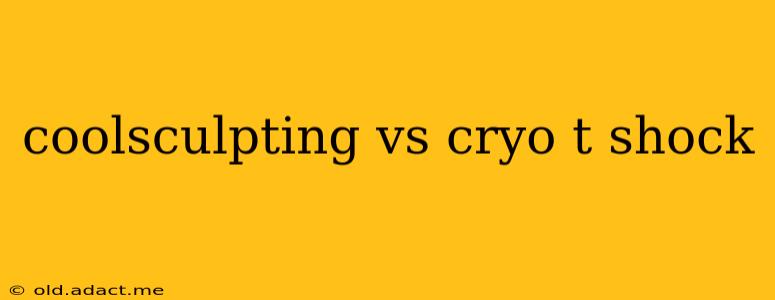Choosing between CoolSculpting and Cryo T Shock for fat reduction can feel overwhelming. Both procedures utilize cryolipolysis, a method that freezes and eliminates fat cells, but they differ significantly in technology, treatment time, and cost. This comprehensive guide will delve into the key distinctions to help you make an informed decision.
What is CoolSculpting?
CoolSculpting, developed by Zeltiq Aesthetics, is a leading non-invasive fat-reduction procedure. It uses controlled cooling to target and eliminate fat cells in specific areas of the body. The frozen fat cells undergo apoptosis (programmed cell death) and are naturally processed and eliminated by the body over several weeks. CoolSculpting is FDA-cleared for various areas, including the abdomen, flanks ("love handles"), thighs, and chin.
What is Cryo T Shock?
Cryo T Shock is a newer technology that also employs cryolipolysis, but with a crucial difference: it uses a combination of cooling and heating cycles. This rapid temperature fluctuation is believed to enhance the effectiveness of fat cell destruction compared to traditional cooling-only methods. Cryo T Shock often boasts shorter treatment times than CoolSculpting and is also designed for a variety of body areas.
CoolSculpting vs. Cryo T Shock: Key Differences
| Feature | CoolSculpting | Cryo T Shock |
|---|---|---|
| Technology | Controlled cooling (single temperature) | Rapid cooling and heating cycles |
| Treatment Time | Longer (typically 35-75 minutes per area) | Shorter (typically 20-30 minutes per area) |
| Number of Treatments | Often requires multiple sessions for optimal results | May require fewer sessions depending on the area and desired results |
| Cost | Generally more expensive per treatment | Typically less expensive per treatment |
| FDA Clearance | FDA-cleared for specific body areas | Often marketed for multiple areas, but FDA clearance may vary depending on specific applicators |
| Downtime | Minimal to none | Minimal to none |
How Long Does It Take to See Results?
CoolSculpting: Results typically appear gradually over 1-3 months as the body naturally eliminates the treated fat cells. Full results may take up to 6 months to be fully visible.
Cryo T Shock: Similar to CoolSculpting, results with Cryo T Shock are gradual and become noticeable within a few weeks to several months. The rapid temperature changes may lead to quicker visible results for some individuals, but this is not universally consistent.
What Are the Side Effects?
Both procedures are generally considered safe, with minimal side effects. Common side effects include temporary redness, swelling, numbness, bruising, and discomfort at the treatment site. These usually resolve within a few weeks. Severe side effects are rare.
Which is Better for Me?
The "better" treatment depends entirely on your individual needs and preferences. Consider these factors:
- Budget: Cryo T Shock is often a more budget-friendly option.
- Time Commitment: Cryo T Shock treatments are quicker, making them suitable for individuals with busy schedules.
- Treatment Area: Both offer options for various areas, but always confirm the FDA clearance for the specific applicator used for your target area.
- Individual Response: Results can vary from person to person, regardless of the chosen treatment.
How Much Does Each Procedure Cost?
Pricing varies significantly depending on the clinic, location, the number of treatment areas, and the extent of treatment needed. It's crucial to consult directly with clinics offering CoolSculpting and Cryo T Shock to get personalized quotes.
Does Cryo T Shock Work as Well as CoolSculpting?
There's ongoing research and debate on the comparative effectiveness of CoolSculpting and Cryo T Shock. While both methods use cryolipolysis, the different approaches may yield slightly different results for different individuals. More clinical data is needed to definitively compare long-term effectiveness.
Are There Any Alternatives to CoolSculpting and Cryo T Shock?
Yes, several other fat reduction methods exist, including liposuction (surgical), laser lipolysis, and radiofrequency treatments. Consulting a qualified medical professional is crucial to determining the most appropriate option for your body type, goals, and health status. Your physician can help you weigh the risks and benefits of each procedure.
Remember to always consult a board-certified dermatologist or plastic surgeon to determine which procedure is best suited for your specific needs and expectations. This information is for educational purposes only and should not be considered medical advice.
